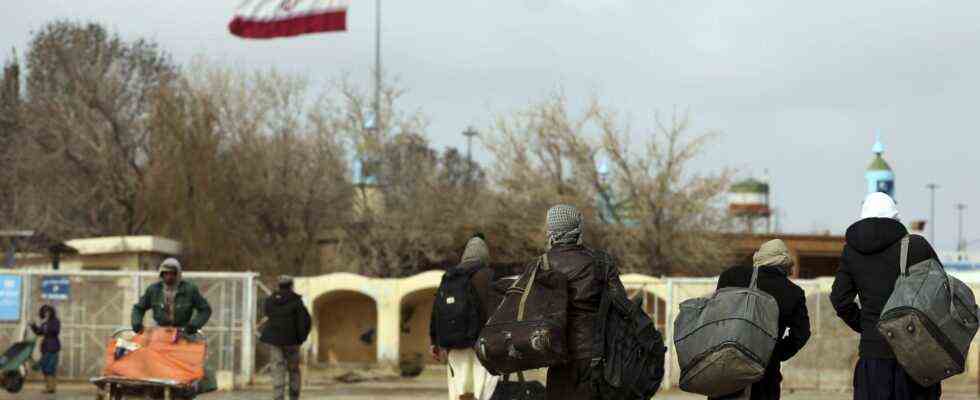Status: 08/27/2021 5:32 a.m.
There has long been open hostility between Iran and the Taliban. Today, Tehran welcomes the return of the Taliban to power – and apparently supported it.
A few days ago the Iranian newspaper “Sharq” reported that Iran had sent around 3,000 Afghan refugees back to Afghanistan at the Hirmand border crossing. According to the newspaper, the deported were said to have been members of the Afghan military and their family members. Other Iranian media reports that the leadership in Tehran has promised to deliver fuel to the Taliban.
The most important crossings on the almost 900 kilometers long shared border will gradually be reopened for goods traffic. On the other hand, she wants to keep Tehran closed for refugees for an indefinite period of time. A good 800,000 registered Afghan refugees and around 2.5 million unregistered Afghans are already living in Iran. The Islamic Republic has no interest in accepting even more people from what the Taliban calls the Islamic Emirate of Afghanistan.
Joy at the withdrawal of the USA
The leadership in Tehran has expressly welcomed the Taliban’s return to power in Afghanistan. The recently elected President Ebrahim Raisi is quoted in the Iranian media as saying: “The military defeat and the US withdrawal from Afghanistan must be seen as an opportunity to restore security and lasting peace in this country.” Raisi announced that his government would maintain good relations with the Taliban and work for the stability and well-being of the Afghan people.
Tehran’s friendly attitude towards the Taliban movement, which is run as a terrorist organization in the West, is by no means new. A good two months ago, a high-ranking Taliban delegation was received by the then Foreign Minister, Mohammad Javad Zarif. High-ranking Taliban leaders have been living in the major Iranian cities of Kharaj near Tehran and Mashhad not far from the Afghan border for years. And then-Taliban leader Akhtar Mohammad Mansour was killed by an American drone in 2016 after crossing the Iranian border into Pakistan.
Assistance with weapons and other equipment
In 2017, the Chief of the General Staff of the Afghan Armed Forces, Mohammad Sharif Yaftali, said in an interview with the British BBC that the government in Kabul had evidence that Tehran was supplying weapons and equipment to the Taliban.
The Iranian Revolutionary Guard is said to have supported the Taliban and other terrorist organizations financially and logistically for years, according to the Afghan government. The Al-Kuds brigades, according to the governor of the western Afghan province of Farah, Mohammad Asif Nang, who have since been deposed by the Taliban, have set up training camps for terrorists on Iranian territory, which are then deployed in Afghanistan.
Three goals
Iran’s cooperation with the Taliban, which has apparently been intensified since 2015, served three main goals: the fight against the terrorist militia “Islamic State”, Iran’s strategic and economic influence in areas controlled by the Taliban, and expulsion of the US armed forces. The open hostility between Tehran and the Taliban at the beginning of the US-led “war on terror” two decades ago apparently no longer played a decisive role in the face of mutual enemies.
In 2001, the US and Iranian intelligence services had cooperated to defeat the Taliban. The predominantly Sunni Taliban took massive action against members of the Shiite minority in Afghanistan during their rule from 1996 to 2001. Iran, as the self-declared protective power of the Shiites, saw the Taliban as a fundamental threat to Shiites.
The end of a brief common ground
The US-Iranian cooperation ended after the Taliban were defeated and the then US President George Bush positioned the Islamic Republic, together with Iraq and North Korea, on the “axis of evil”. Hardliners and opponents of reform in Tehran saw themselves confirmed in the fact that cooperation with Washington and rapprochement with the USA could only damage the Islamic Republic. The war against Iran’s neighboring country Iraq, the overthrow of its ruler Saddam Hussein and the stationing of American troops in other neighboring countries of Iran fueled the assumption in Tehran that Washington is aiming for a regime change in Iran.
The Iranian leadership decided to counter the pressure of the USA and its allies with asymmetrical means – i.e. with terrorist attacks. In addition to the intensified cooperation with the Taliban, this also includes the connection to the terror network Al Qaeda, which Tehran has always rejected. But the killing of Abu Mohammad al Masri, founding member and number two of al Qaeda, is just one indication among many of the close ties between Iran and the terrorist organization. Al Masri was apparently shot dead by Mossad agents in northern Tehran in mid-November last year.
Does the new peace hold?
Whether the cooperation between Tehran and the Taliban will continue after the Americans have withdrawn depends heavily on how the Taliban treats the Shiites of Afghanistan and Iran’s allies in the country. Should the Iranian regime see its interests threatened, it could be tempted to lead thousands of Shiite fighters from Afghanistan, whom it has deployed as mercenaries in Syria, to fight the predominantly Sunni Taliban. Many of them have already returned to Afghanistan and could be mobilized quickly.
Difficult neighborhood: Iran and Afghanistan – conversation with Reinhard Baumgarten
Andreas Noll, DLF, August 21, 2021 1:33 p.m.

